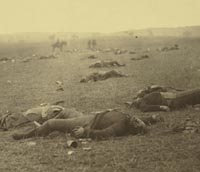|
The Battle of Gettysburg Pennsylvania's Governor Andrew Curtin responded to the crisis by purchasing 17 acres of land for a proper burial ground for the Union dead. Within four months of the battle, reinterment began on the land that became Gettysburg National Cemetery. By the time of the dedication ceremony for the cemetery on November 19, 1863, less than half the Union battle dead had been removed from their field graves. Within a few years, however, the bodies of more than 3,500 Union soldiers killed in the battle had been reinterred in the cemetery. Following the war, the remains of 3,320 Confederate soldiers were removed from the battlefield to cemeteries in the South. Today the cemetery is the final resting place for over 6,000 honorably discharged servicemen and their dependents from the Civil War, Spanish-American War, World War I, World War II, and the Vietnam War.
|
||||||||||||||||||||||||
